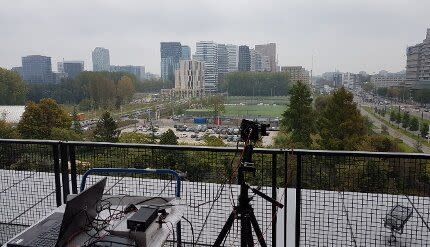Alien Plant Hunter Taking First Steps on Earth. Next Stop: Jupiter

The science fiction of Star Trek has been inspiring scientists for generations in ways big and small. As mentioned in the opening credits of both the original series and The Next Generation, one focus for the ships in Star Trek's Federation is "to seek out new life," which can be easily done thanks to technology capable of remotely scanning an area for life forms. Scientists have now made steps toward recreating that technology in the form of a specialized camera called a TreePol spectropolarimeter.
All living organisms have what are known as chiral molecules, which can reflect, refract, or diffract light. The TreePol spectropolarimeter has lenses and receptors able to detect rotating light reflected by plants. TreePol is specifically designed to detect circularly polarized light, a type of electromagnetic wave that rotates either clockwise or counterclockwise, reflected from foliage.
In a test, biologist Lucas Patty attempted to use the TreePol on a soccer field in Amsterdam. But to his surprise, he got no results. "I went over to investigate, and it turned out that the team play on artificial grass!" he says. Patty then turned the camera toward real trees and got very accurate results.

The molecules then form chains, which take either "left" or "right" sided versions. On Earth, at least, living organisms pick one side and stick with it.
"Biology breaks this symmetry," Frans Snik, an astronomer at Leiden University in the Netherlands and co-author of the new paper, tells Live Science. "This is the difference between chemistry and biology."
As plants die, their chiral molecules die with them. That changes their ability to rotate circularly polarized light.
Early tests were performed in February 2019, and now a paper published in the journal Astrobiology further describes TreePol's abilities. Currently, it can detect living plants "up to distances of a few kilometers," reads the paper's abstract. But its scientific potential stretches much further.
In the short term, scientists hope the TreePol could be used to monitor agricultural crops from above, from either a plane or a satellite. In the long term, the team hopes it could even be used to scan for plant life on other worlds.
"We are also working on a version that could be employed on the international space station or on a moon lander," Snik said in a press statement in February.
A true interdisciplinary work, the TreePol required biologists, astronomers, chemists and geologists. "This result shows the value of collaborations between scientists who work in very different fields," said astrobiologist Inge Loes ten Kate of Utrecht University, a participant in the project, in February.
There are many challenges to the possibility of using the TreePol for extraterrestrial life. First, there's the fact that alien trees might be structured in a way that's completely, well, alien. Alien plants being carbon-based is a bet, but one Snik is willing to wager.
Then there's distance. If scientists want to study exoplanets with an advanced version of TreePol, they would likely require huge space-based telescopes far beyond anything seen today. But Snik thinks the search doesn't have to go so far. It could start scanning a moon like Jupiter's Europa, perhaps the best candidate for alien life forms in the solar system.
"Maybe our first detection of extraterrestrial life will be in our backyard," Snik tells Live Science.
Source: Live Science
You Might Also Like
